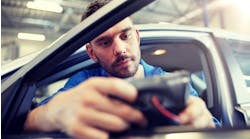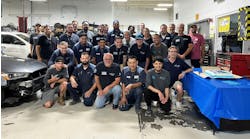There are many reasons to convert to waterborne coatings, with the principal one being that in the future, shops will be required to convert. See what else is driving your shop to change.
The simple answer to the question above is that environmental regulations are going to demand it! But as with most developments, the full answer is more complex than that.
Paints that use water as their primary solvent have been used successfully for the past few years in Europe. You will note that I use the phrase "primary solvent." One of the common misconceptions is that waterborne paints have no solvents other than water in them, and that is not true. Water, not tap water but de-ionized water, is the primary solvent, but the paints still contain as much as 25 percent traditional VOC-laden solvents depending on the brand of paint.Reducing the amount of VOC solvents in basecoat paint can reduce the amount of smog-causing emissions from automotive aftermarket refinishing by 75 percent or more. Some states have not met their current clean air emissions goals; others have, or are awaiting new regulations with a goal of reducing the VOC emissions by 70 percent or more. In California and Canada, new tighter emission regulations are in place already, and it is reasonable to believe that in other states, similar legislation will follow shortly.
Waterborne paints are not new technology, first being introduced over 17 years ago in California in anticipation of new tighter VOC regulations. In fact, even before the introduction of waterborne basecoats in the 1990s, waterborne undercoat was available as a barrier coat between troublesome lacquer substrates and new finish. Though waterborne technology has advanced since its general availability in the 1990s, a suitable waterborne clearcoat is not yet available.
While waterborne finishes for undercoats and basecoats are common, basecoat must still be protected with a solvent-laden, high-solids clearcoat. To solve the problem, paint companies are working on a waterborne clearcoat, and some of the most exciting research in this area involves UV (ultraviolet)-cured waterborne clears. If waterborne UV-cured clears can be developed, the application of a clearcoat with no VOCs in it (that cures in minutes or even seconds) may be the next revolution in refinishing.There are also other advantages for technicians in using or switching to waterborne paint before regulations require us to. First, cure time can be reduced, with the correct equipment, by using waterborne paints. Additionally, color match, metallic orientation and blending can be enhanced with the use of waterborne basecoats; and technician safety is markedly increased when waterborne coatings are used. Though one of the myths about waterborne paints is that technicians need to use special respirators when applying water finishes, this fact is not supported in the product MSDS literature.
So what must a shop know and expect to change when considering switching to waterborne equipment? Though often it is claimed that a shop could convert to waterborne coatings with no new equipment, in order to benefit from all the advantages of fast curing and application, some new or additional equipment will be needed. Storage and cleanup are different, and the shop may need to make spray gun changes.
Equipment
One of the most often asked questions is, "Will I need new spray booths and spray guns?" Though new spray booths will not be needed, some changes in drying/curing equipment may be. Most paint manufacturers recommend that a downdraft spray booth, which has the capacity to move large amounts of air, is the best type of booth to use; some booths may not move the needed amount of air for fast drying of waterborne finishes.
Traditional solvent-borne basecoats dry through evaporation, and though atmospheric humidity does affect the drying time of these finishes, temperature has a stronger influence on their curing time. Baking-type spray booths can significantly increase the cost of using solvent-borne paints. When waterborne paints are used, the cost of baking is markedly reduced. To speed up the cure time, a technician can choose a "faster" reducer and/or increase the temperature of the booth to reduce the coating's cure time.
With waterborne finishes, air movement is what influences its dry time the most, because water must evaporate from the finish. Though atmospheric humidity does influence the ability of a waterborne coating to evaporate, if air is moved rapidly over the surface of the painted vehicle, its evaporation is speeded up. Another phenomenon is that when water evaporates out of a finish, it increases the humidity of the air just above the painted surface. By circulating large amounts of air in the booth, this area just over the evaporating surface has the high humidity moved and lower-humidity air takes its place, thus increasing drying.
Many booths that exist now may not move the needed amount of air, so to increase booth air movement special blowers called ventures may need to be added. Booths designed for waterborne finishes have venturis permanently installed. For existing booths, a movable venturi or venturis can be placed in the booth, circulating air around the area on the vehicle which has been painted.
One of the biggest enemies of a painter is dirt, and the natural question would be, "If all this air must be moved past fresh paint, isn't it likely that it will become dirty?" The answer is — yes. The air that is passed through the venturis must be scrupulously clean.
Another consideration may need addressing also. Though paper booth filters are not used much anymore, there are some booths that still use them. With all the water used with waterborne paints, paper filters can be damaged when used in conjunction with waterborne coatings.
Concerning spray guns, most spray guns being used today for solvent-based paints can also be used for the application of waterborne coatings. Though the technician must consider the recommended needle and nozzle sizes provided by paint manufacturers, gun cleanup may need to be altered. When traditional guns are used with waterborne paints, they should be cleaned with water first to remove the waterborne paint, and then rinsed with either solvent or alcohol to remove the water. Older guns have non-coated steel in them, which would be susceptible to corrosion when water only is used to clean them. Newer water-ready paint guns have stainless steel or coated parts, which water does not affect, and water only can be used to clean the equipment.
Technicians now have specially-designed guns available for water application. These guns not only address the corrosion problem but also have addressed the gun's ability to atomize waterborne paint. Shops that are contemplating switching to waterborne finishes may want to consider guns specifically designed for waterborne coating applications.
Training
Though the many paint companies will state that the switch to waterborne paint can be made easily, which is somewhat true, still making the switch is not without its learning curve. When the National Rule took effect, high-solids coatings became the standard. With the use of higher viscosity paints, more texture in the finish became a common side effect. When water is the primary solvent, paint coatings are not restricted by the amount that can be added, thus letting technicians apply coating with little or no texture. Though high-solids solvent-borne clears are still needed to finish a refinish paint job, texture is much less a problem that it has been in the past.
Paint and spray gun manufacturers continue to make products that lend themselves to the change with as little application technique change as possible. Technician training may still be one of the best investments a shop can make, when changing to waterborne coatings.
Storage
With water, the principal solvent in waterborne coatings, freezing may become a problem. Transportation of product in the winter may require vehicles which have the ability to keep paint product from freezing. Storage at paint stores and in body shops also must be in heated areas, to avoid freezing. Even when there is no danger of freezing, the paints need to be applied at suitable temperatures to avoid atomization and flow problems.
Reduction
A common misconception with waterborne coatings is that a paint shop can just take water from the tap to reduce the coating. The water used to reduce waterborne coatings must be de-ionized, and thus most companies recommend and supply the precise type of reducing water for their finishes. Any contaminant such as iron or other minerals in common tap water would cause undesirable side effects.
Safety
As mentioned earlier, waterborne coatings are much safer for the environment and the technician applying the coating. That is not to say that personal protective equipment will not be needed. Technicians must still read, understand, and follow all the safety precautions listed in the product MSDS. Paint manufacturers, in their quest to help paint shops reduce throughput cycle times, work continuously on developing safer coatings. Nonetheless, with the amount of hazardous ingredients they routinely are exposed to, paint technicians must be diligent in their pursuit of personal safety,
There are many reasons to convert to waterborne coatings, with the principal one being that in the future, shops will be required to convert. Next, using waterborne is significantly safer for the environment, and likewise for technicians. In addition, because the more expensive chemical solvents have been significantly reduced in waterborne paints, they may even be lower in price as they become more popular. With the proper time cycle, time can be significantly reduced when paired with fast cure time clearcoats. It is also significantly cheaper to operate venturis with compressed air than to operate paint booth bake ovens.
While waterborne conversion will be required, the requirement will also bring significant advantages for the industry without significant adjustments or decreased profits.



